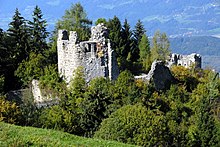
The Counts of Celje or the Counts of Cilli were the most influential late medieval noble dynasty on the territory of present-day Slovenia. Risen as vassals of the Habsburg dukes of Styria in the early 14th century, they ruled the County of Cilli as immediate counts (Reichsgrafen) from 1341. They soon acquired a large number of feudal possessions also in today's Croatia and Bosnia. They rose to Princes of the Holy Roman Empire in 1436. The dynasty reached its peak with Ulrich II of Cilli, but with his death in 1456 they also died out, and after a war of succession, the Habsburgs inherited their domains.

Henry of Gorizia, a member of the House of Gorizia, was Duke of Carinthia and Landgrave of Carniola and Count of Tyrol from 1295 until his death, as well as King of Bohemia, Margrave of Moravia and titular King of Poland in 1306 and again from 1307 until 1310. After his death, the Habsburgs took over Carinthia and Carniola and held them almost without interruption until 1918.

Meinhard II, a member of the House of Gorizia (Meinhardiner), ruled the County of Gorizia and the County of Tyrol together with his younger brother Albert from 1258. In 1271 they divided their heritage and Meinhard became sole ruler of Tyrol. In 1286 he was enfeoffed with the Duchy of Carinthia and the adjacent March of Carniola.

Albert I, a member of the House of Gorizia, ruled the counties of Gorizia (Görz) and Tyrol from 1258, jointly with his elder brother Meinhard IV. In 1271, the brothers divided their heritage and Albert became sole ruler of the Gorizia estates until his death. His descendants, known collectively as the Albertine line, ruled the County of Gorizia until the extinction of the House in 1500.

Meinhard I, a member of the House of Gorizia (Meinhardiner), was Count of Gorizia from 1231 and Count of Tyrol from 1253 until his death.

Spittal an der Drau is a town in the western part of the Austrian federal state of Carinthia. It is the administrative centre of Spittal an der Drau District, Austria's second largest district (Bezirk) by area.

The (Princely) County of Tyrol was an estate of the Holy Roman Empire established about 1140. After 1253, it was ruled by the House of Gorizia and from 1363 by the House of Habsburg. In 1804, the County of Tyrol, unified with the secularised prince-bishoprics of Trent and Brixen, became a crown land of the Austrian Empire. From 1867, it was a Cisleithanian crown land of Austria-Hungary.

The County of Gorizia, from 1365 Princely County of Gorizia, was a State of the Holy Roman Empire. Originally mediate Vogts of the Patriarchs of Aquileia, the Counts of Gorizia (Meinhardiner) ruled over several fiefs in the area of Lienz and in the Friuli region of northeastern Italy with their residence at Gorizia (Görz).

The Counts of Gorizia, also known as the Meinhardiner, House of Meinhardin, were a comital, princely and ducal dynasty in the Holy Roman Empire. Named after Gorizia Castle in Gorizia, they were originally "advocates" (Vogts) in the Patriarchate of Aquileia who ruled the County of Gorizia (Görz) from the early 12th century until the year 1500. Staunch supporters of the Emperors against the papacy, they reached the height of their power in the aftermath of the battle of Marchfeld between the 1280s and 1310s, when they controlled most of contemporary Slovenia, western and south-western Austria and part of northeast Italy mostly as (princely) Counts of Gorizia and Tyrol, Landgraves of Savinja and Dukes of Carinthia and Carniola. After 1335, they began a steady decline until their territories shrunk back to the original County of Gorizia by the mid 1370s. Their remaining lands were inherited by the Habsburg ruler Maximilian I.

Ulrich II, or Ulrich of Celje, was the last Princely Count of Celje. At the time of his death, he was captain general and de facto regent of Hungary, ban (governor) of Slavonia, Croatia and Dalmatia and feudal lord of vast areas in present-day Slovenia, Croatia, Bosnia, Austria, and Slovakia. He was also a claimant to the Bosnian throne. He was killed by agents of the Hunyadi clan under unknown circumstances, which plunged Hungary into civil unrest that was resolved a year later by the sudden death of king Ladislas the Posthumous and the election of Matthias Corvinus, the son of John Hunyadi and Ulrich's son-in-law, as king. Ulrich's possessions in the Holy Roman Empire were inherited by Emperor Frederick III, while his possessions in Hungary were reverted to the crown.

Lurnfeld is a market town in the district of Spittal an der Drau in the Austrian state of Carinthia. The municipality consists of the two Katastralgemeinden: Möllbrücke and Pusarnitz, comprising several small villages.
The House of Sponheim or Spanheim was a medieval German noble family, which originated in Rhenish Franconia. They were immediate Counts of Sponheim until 1437 and Dukes of Carinthia from 1122 until 1269. Its cadet branches ruled in the Imperial County of Ortenburg-Neuortenburg and various Sayn-Wittgenstein states until 1806.

Ortenburg Castle is a ruined mediaeval castle located in Baldramsdorf, in the Austrian state of Carinthia. It is located on the northern slope of Mt. Goldeck, part of the Gailtal Alps, above the Drava valley at a height of 740 m (2,430 ft).

Sommeregg is a medieval castle near Seeboden in the Austrian state of Carinthia, Austria. It is situated in the foothills of the Nock Mountains at an altitude of 749 m.
Andreas von Graben zu Sommeregg was a Carinthian knight and nobleman residing at Sommeregg Castle. He served as a burgrave and castellan governor in the Ortenburg estates, held by the Counts of Celje until 1456. With the extinction of the Cillier family, Von Graben lost the post of captain of the County of Ortenburg under the Habsburgs, their successors as Ortenburg sovereign.

Meinhard VI of Gorizia a member of the Meinhardiner dynasty, an imperial prince and a count of Gorizia.
Count Ulrich V of Pfannberg was Count of Pfannberg. From 1322 to 1337, he was governor of Gornji Grad and from 1330 Marshal of the Duchy of Austria. From 1330 to 1335, he was also governor of Carinthia.

Agnes of Baden, was a German noblewoman by birth member of the House of Baden and by her two marriages Duchess of Carinthia and Countess of Heunburg.

Frederick I of Celje, also Frederick I of Cilli, was a Styrian free noble who became the first Count of Celje, founding a noble house that would dominate Slovenian and Croatian history in the first half of the 15th century.

Ulrich of Sanneck, Lord of Žovnek, was a free noble in the March of Savinja in what was then the Holy Roman Empire and is now in Slovenia. During the struggle between Henry, Duke of Carinthia and the Habsburg rulers of Austria and Styria, he sided with the latter. By accepting the Habsburgs as his liege lords, he was instrumental in transferring the lordship over the Savinja region from the Meinhardiner-dominated Carniola to Habsburg Styria. His second marriage with the noblewoman Catherine of Heunburg would enable their son to claim the Heunburg inheritance in Carinthia and in the Savinja Valley, including the strategically important Celje Castle. This union of the Sanneck (Žovnek) and Heunburg (Vovbre) noble houses would give birth to the House of Celje.


















